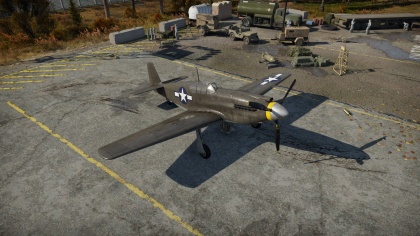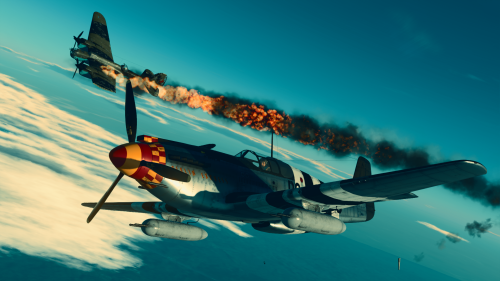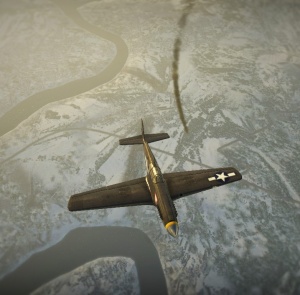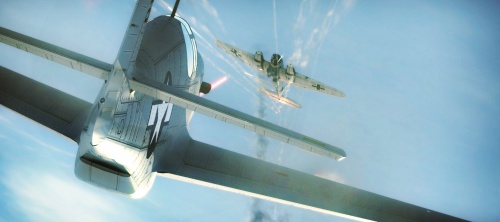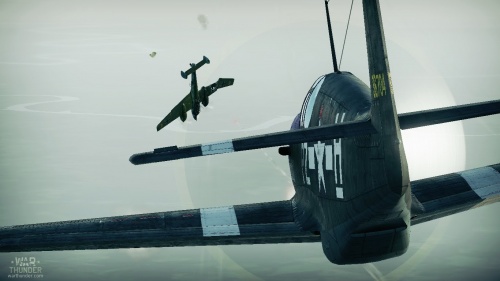Difference between revisions of "A-36"
(Updated description.) |
m (Updated image location.) |
||
| Line 21: | Line 21: | ||
=== Flight performance === | === Flight performance === | ||
''Describe how the aircraft behaves in the air. Speed, manoeuvrability, acceleration and allowable loads - these are the most important characteristics of the vehicle.'' | ''Describe how the aircraft behaves in the air. Speed, manoeuvrability, acceleration and allowable loads - these are the most important characteristics of the vehicle.'' | ||
| − | + | [[File:A-36 billythekid 001.png|500px|thumb|right|An '''{{PAGENAME}}''' doing what it does best.]] | |
{| class="wikitable" style="text-align:center" | {| class="wikitable" style="text-align:center" | ||
|- | |- | ||
| Line 63: | Line 63: | ||
==== Details ==== | ==== Details ==== | ||
| − | |||
{| class="wikitable" style="text-align:center" | {| class="wikitable" style="text-align:center" | ||
|- | |- | ||
Revision as of 11:43, 4 October 2019
Contents
Description
The A-36 Apache is a rank II American attacker
with a battle rating of 2.7 (AB/RB/SB). It was introduced in Update 1.51 "Cold Steel".
North American Aviation Company was busy during 1942 building and shipping Mustang Mk.I fighters to England to be incorprated into the Royal Air Force to fight along side the Curtiss P-40 Tomahawks. Unfortunately for England, lend-lease funds ran out and 93 unshipped Mustang IA/P-51s went to the U.S. Army Air Forces. North American did not want to stop production of the P-51s and pressured the USAAF for a fighter contract. Unfortunately for the fiscal year 1942, no government funds were available for new fighter aircraft, however when observed that attack aircraft funds were available, North American reconfigured the Mustang into a dive bomber, outfitting it with heavier wings, bomb racks and dive brakes. With this dive bomber/attack variant approved for manufacturing, NAA ramped up production and cranked out 500 A-36A aircraft.
The A-36 was outfitted with the Allison V-1710-87 inline water-cooled engine which was a failure for high altitude flying, however for lower altitude dive-bombing, this engine performed quite well. High enough speeds could be developed in a dive to rip the wings, so dive brakes were implemented to regulate the dive speed to around 390 mph (630 kph). Maintaining speed in a dive ensures enough energy is available to zoom climb back up to altitude or to get away from any enemy fighters which may have attempted to intercept you. Depending on the map, if there are a significant amount of ground targets (anti-aircraft batteries, trucks, light tanks...etc…) the dive bomber can convert to a strafing aircraft once the bombs are released. With six 12.7 mm machine guns, softer ground targets are no match and will be easy pickings.
The A-36 has a configuration which few other aircraft (U.S. and foreign) can be outfitted with and that is two DGP-1 gun pods, with one being mounted under each wing. Each gun pod contains two more 12.7 mm M2 Browning machines guns with 340 RPG, bringing up the total machine gun count to 10 12.7 mm M2 machine guns with 2,700 rounds per load. En mass, these machine guns can produce devastating results both in the air and on the ground. While only two guns are mounted in the fuselage cowling, the other four (or eight if gun pods are equipped) are mounted in the wings and require the pilot to set convergence for best results. For those pilots which like to snipe from a distance, 500 – 650 m convergence may work best while those pilots who like to fight close quarters, a convergence of 250 – 350 m can be extremely devastating when all 10 guns bear down on the target.
As an early war multi-role aircraft, the A-36 can fit the play-style of just about any pilot and can be reconfigured to accommodate different maps and missions. Whether ground-pounding or dismantling aircraft with 10 guns at a time, the Apache (or Mustang as pilots typically referred to it as), this aircraft will help pilots to hone their skills and prepare for the rest of the Mustang series available to play in War Thunder. Don’t be surprised when heading towards an enemy aircraft that they immediately take evasive manoeuvres to get away from the A-36 as they fully understand what could be in store for them if they stick around.
General info
Flight performance
Describe how the aircraft behaves in the air. Speed, manoeuvrability, acceleration and allowable loads - these are the most important characteristics of the vehicle.
| Characteristics | |||||||
|---|---|---|---|---|---|---|---|
| Stock | |||||||
| Max Speed (km/h at 1,760 m) |
Max altitude (meters) |
Turn time (seconds) |
Rate of climb (meters/second) |
Take-off run (meters) | |||
| AB | RB | AB | RB | AB | RB | ||
| 556 | 542 | 9000 | 23.4 | 24.2 | 9.7 | 9.7 | 400 |
| Upgraded | |||||||
| Max Speed (km/h at 1,760 m) |
Max altitude (meters) |
Turn time (seconds) |
Rate of climb (meters/second) |
Take-off run (meters) | |||
| AB | RB | AB | RB | AB | RB | ||
| 621 | 589 | 9000 | 21.3 | 22.3 | 17.4 | 13.1 | 400 |
Details
| Features | ||||
|---|---|---|---|---|
| Combat flaps | Take-off flaps | Landing flaps | Air brakes | Arrestor gear |
| ✓ | ✓ | ✓ | ✓ | X |
| Limits | ||||
|---|---|---|---|---|
| Wing-break speed (km/h) |
Gear limit (km/h) |
Combat flaps (km/h) |
Max Static G | |
| + | - | |||
| 652 | ~11 | ~5 | ||
| Optimal velocities | |||
|---|---|---|---|
| Ailerons (km/h) |
Rudder (km/h) |
Elevators (km/h) |
Radiator (km/h) |
| < 550 | < 230 | < 550 | > 360 |
| Compressor (RB/SB) | ||
|---|---|---|
| Setting 1 | ||
| Optimal altitude | 100% Engine power | WEP Engine power |
| 762 m | 1,325 hp | 1,500 hp |
Survivability and armour
- Protective plates and glass
- 38 mm Bulletproof glass in front of the pilot
- 11.11 mm Steel plate behind the pilot
- 6.35 mm Steel plate in front of the engine
- 6.35 mm Steel plate between engine and pilot
The A-36’s armour configuration does a decent job of protecting the pilot, especially in frontal or head-on attacks. From behind the pilot’s seat backs up to an 11.11 mm steel plate, however from the front, the canopy windscreen contains 38 mm bulletproof glass. There is also a 6.35 mm steel plate both in front of the engine and behind it between the engine and the cockpit. To get to the pilot, bullets from the front will need to pass through the first plate, the engine and then the second plate. The chances are the engine will be disabled before the pilot is knocked out in a head-on attack. The front-most steel plate will help to protect the engine from smaller calibre machine gun fire, however, it does not fare so well once you start going against +20 mm rounds which have a greater punch.
Keep up speed and manoeuvrability which will make it difficult for any enemy fighter to get a bead on you and the different steel plates should do their job in protecting the fighter from stray bullets. The A-36 when outfitted with gun pods can become an absolute terror especially during head-on attacks, however, don’t think that just because of the armour in the aircraft, you are fine. Remember when performing head-on or diving attacks on bombers fire off rounds and then manoeuvre as bullets headed your way in which you fly into will have a greater impact, it is imperative to move out of their way rather than take a chance and hope that a 6.35 mm steel plate will fully protect the engine or the pilot.
Armaments
Offensive armament
The A-36 is armed with:
- 2 x 12.7 mm Browning M2 machine guns, chin-mounted (300 rpg = 600 total)
- 4 x 12.7 mm Browning M2 machine guns, wing-mounted (350 rpg = 1,400 total)
Suspended armament
The A-36 can be outfitted with the following ordnance:
- Without load
- 2 x 100 lb AN-M30A1 bombs (200 lb total)
- 2 x 250 lb AN-M57 bombs (500 lb total)
- 2 x 500 lb AN-M64A1 bombs (1,000 lb total)
- 4 x 12.7 mm Browning M2 machine guns, wing-mounted (340 rpg = 1,360 total)
Usage in battles
The A-36 is quite a unique aircraft for its rank. It is a sleek looking fighter-bomber and should be used as such. It has good speed for its rank and designation, decent armament and a good selection of payloads; the A-36's role varies depending on the game mode you play.
Air Arcade and Air Realistic - In air battles, you can target ground forces with your .50 cals, equip bombs and take out medium or heavy tanks or you can specialise as a fighter. For a slight performance drop, you can equip the gun pods, which makes this plane absolutely formidable against any aircraft, especially during head-on attacks. Fighters and bombers alike will take heavy damage if not fully destroyed by the ten .50 calibre machine guns. Generally, it is best to focus on enemy aircraft in Air Arcade, while leaving the ground attack to more dedicated aircraft.
Ground Realistic - Ground RB allows you to really let the A-36 shine. It performs very well in the fighter-bomber role. If you equip bombs, you can quickly dive into battle, bomb a target and then begin engaging enemy aircraft. If you instead equip the gun pods, you should also equip the ground targets belt. The high amount of AP ammunition allows you to penetrate most German and Japanese vehicles through the roof, while the belt still retains high levels of effectiveness against aircraft, allowing you to be a true multi-role fighter bomber. The gun pods also allow you to hunt heavily armoured aircraft like the IL2.
Tip: taking off in Simulator Battles
Sea-level maximum speed (Auto engine control, no secondary weapons): Altitude: just above sea level (minimum safe altitude: 5m/16ft), 100% throttle, elevator trim: 4% up, aileron trim: 1% left, rudder trim: 0%, you should get a true air speed of 523 kph/325 mph/282 kt. Maximum true speed (Auto engine control, no secondary weapons): Altitude: 1,760 m/5,775 ft, 100% throttle, elevator trim: 5% up, aileron trim: 1% left, rudder trim: 0%, you should get a true air speed of 536 kph/333 mph/289 kt.
Manual Engine Control
| MEC elements | ||||||
|---|---|---|---|---|---|---|
| Mixer | Pitch | Radiator | Supercharger | Turbocharger | ||
| Oil | Water | Type | ||||
| Not controllable | Not controllable Not auto controlled |
Not controllable Auto control available |
Controllable Auto control available |
Combined | Not controllable 1 gear |
Not controllable |
Modules
| Tier | Flight performance | Survivability | Weaponry | ||
|---|---|---|---|---|---|
| I | Fuselage repair | Radiator | Offensive 12 mm | DGP-1 | |
| II | Compressor | Airframe | FSBC mk.5 | ||
| III | Wings repair | Engine | New 12 mm MGs | ||
| IV | Engine injection | Cover | FMBC mk.1 | ||
Pros and cons
Pros:
- Decent armament for its rank
- Fast bomb reload unlike typical fighters in Arcade
- Highly agile for an attacker
- Two of the 6 x M2 12.7 mm machine guns are mounted under the fuselage, increasing accuracy
- Superior firepower than most other planes in rank
- Very good energy retention for an attacker
- Good performance at low altitude
- Very good dive speed
- Has air brakes
- Attacker spawn point, can be used to certain advantage
- It's a modified version the P-51 making it a decent fighter with the addition of two 12.7 mm machine guns in the bottom of the nose
- Can opt to equip 2 x DGP-1 gunpods, adding further 4 x 12.7 mm M2's to it's armament, giving the A-36 a very high burst-mass compared to its contemporaries
Cons:
- Fuselage mounted M2's are hooked up to a synchronizer, lowering their effective rate of fire (prevents them from shredding the propeller)
- Carrying payload slows you down
- Is not a dedicated attacker unlike the A-20G-25
- Will be easily out turned by fighters of other nations
- Does not have access to rockets or bombs over 500 lb, making it difficult to use against heavily armoured targets
History
Describe the history of the creation and combat usage of the aircraft in more detail than in the introduction. If the historical reference turns out to be too long, take it to a separate article, taking a link to the article about the vehicle and adding a block "/ History" (example: https://wiki.warthunder.com/(Vehicle-name)/History) and add a link to it here using the main template. Be sure to reference text and sources by using <ref></ref>, as well as adding them at the end of the article with <references />. This section may also include the vehicle's dev blog entry (if applicable) and the in-game encyclopedia description (under === In-game description ===, also if applicable).
Media
Excellent additions to the article would be video guides, screenshots from the game, and photos.
See also
Links to the articles on the War Thunder Wiki that you think will be useful for the reader, for example:
- reference to the series of the aircraft;
- links to approximate analogues of other nations and research trees.
External links
Paste links to sources and external resources, such as:
- topic on the official game forum;
- encyclopedia page on the aircraft;
- other literature.
| USA strike aircraft | |
|---|---|
| Douglas | A-20G-25 · A-26B-10 · A-26B-50 · A2D-1 · AD-2 · AD-4 · A-1H |
| North American | A-36 · PBJ-1H · PBJ-1J |
| Other | AM-1 · AU-1 · XA-38 |



